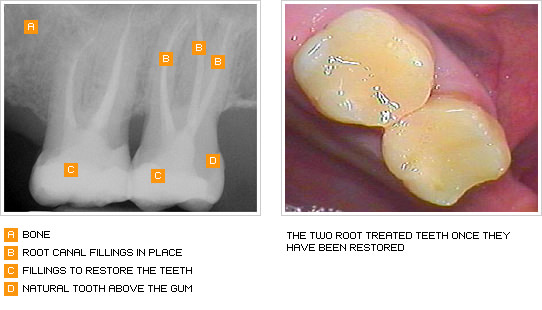A root canal filling is a way of keeping a tooth, once the live part (the pulp) has become irreversibly damaged.
The pulp is a mixture of nerve fibres and tiny blood vessels that can become very inflamed (giving tooth ache) or die off (causing an abscess). This can happen either in the presence of tooth decay or after a heavy blow to the tooth.
The aim of the procedure is to painlessly remove the damaged pulp, under local anaesthetic, and remove any infection that may be present. Once the canals have been cleaned and shaped they are filled with a special filling material. This work is usually carried out over two visits of up to 90 minutes a time. Once the root canal filling is in place, the crown of the tooth is restored with a large filling or cast restoration.
An Example of Root Canal Filled Teeth
Are root fillings always successful?
Root canal fillings are a very successful treatment, with success rates well over 90% for many teeth. Obviously some cases do fail, most commonly when teeth are either very broken down or have an unusually complex root structure. Failure can also occur when the root canals are infected with bacteria that are resistant to the anti-bacterial pastes that are used.
Why does a root filling cost so much more than a normal filling?
A root canal filling takes much longer than a routine filling, usually over two visits and the fees reflect this. As well as the extra time, root canal fillings also require a great deal of specialist equipment and extra training, which adds to the overall cost.
Do root fillings hurt?
With careful use of local anaesthetic a root canal filling can be completely painless from start to finish. When a root canal filling is being done to a tooth that has been causing toothache, it will take the pain away and leave the patient feeling much better.
My dentist says I need a root filling but the tooth doesn’t hurt me, so why should I bother?
When a tooth has died off there is often no pain from it, usually because the pulp has been destroyed. Although there is no pain, there will be infection present that will lead to an abscess. Early treatment of the tooth will remove this infection before it worsens and will prevent the abscess from becoming a problem.
If I don’t want a root filling what other choices have I got?
Once the pulp of the tooth has become irreversibly damaged then a root canal filling is the only way of keeping the tooth. The only alternative treatment is to extract the tooth. Before making a decision on whether to save a tooth or not, any patient should consider how much it would cost to replace the tooth, and how this work will affect the teeth round about. Keeping the tooth with a root canal filling is usually the cheapest, least destructive option.
Download a PDF of this page by clicking here
(Requires Adobe Acrobat Reader – download it for free by clicking here)
For more information or to book an appointment at our dentist practice in Kent please contact our Reception Team on 01580 752202 or info@stonerock.co.uk and they will be very happy to help.
